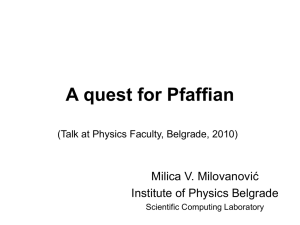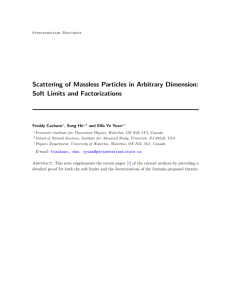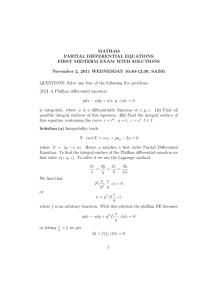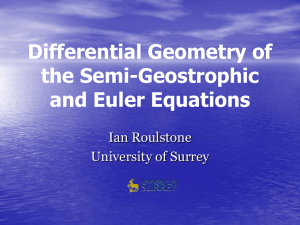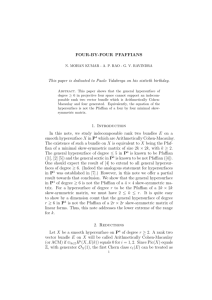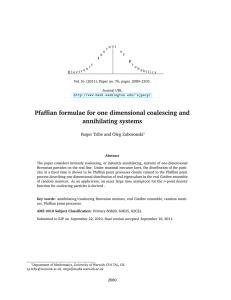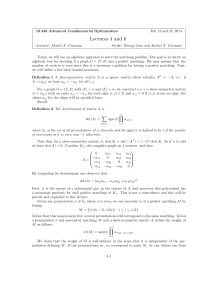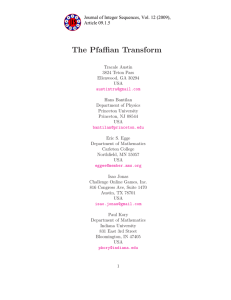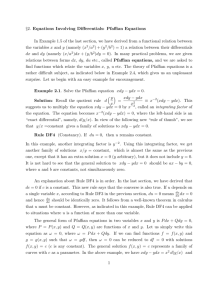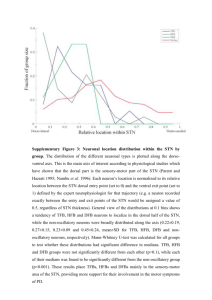One dimensional annihilating and coalescing particle Roger Tribe Siu Kwan Yip
advertisement
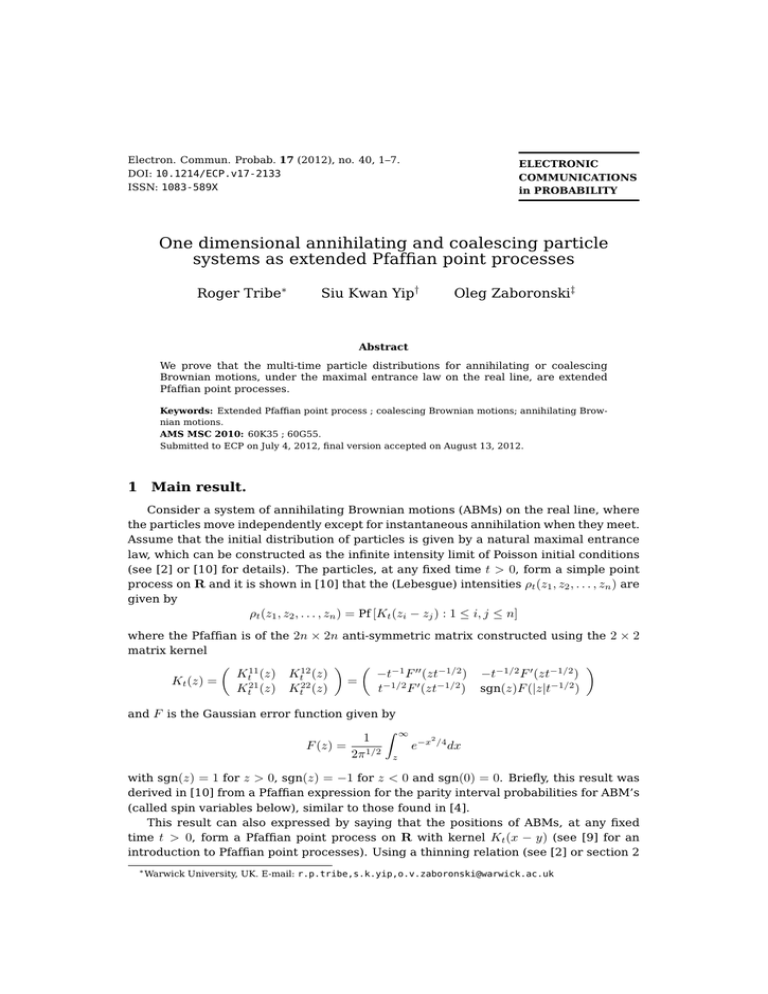
Electron. Commun. Probab. 17 (2012), no. 40, 1–7.
DOI: 10.1214/ECP.v17-2133
ISSN: 1083-589X
ELECTRONIC
COMMUNICATIONS
in PROBABILITY
One dimensional annihilating and coalescing particle
systems as extended Pfaffian point processes
Roger Tribe∗
Siu Kwan Yip†
Oleg Zaboronski‡
Abstract
We prove that the multi-time particle distributions for annihilating or coalescing
Brownian motions, under the maximal entrance law on the real line, are extended
Pfaffian point processes.
Keywords: Extended Pfaffian point process ; coalescing Brownian motions; annihilating Brownian motions.
AMS MSC 2010: 60K35 ; 60G55.
Submitted to ECP on July 4, 2012, final version accepted on August 13, 2012.
1
Main result.
Consider a system of annihilating Brownian motions (ABMs) on the real line, where
the particles move independently except for instantaneous annihilation when they meet.
Assume that the initial distribution of particles is given by a natural maximal entrance
law, which can be constructed as the infinite intensity limit of Poisson initial conditions
(see [2] or [10] for details). The particles, at any fixed time t > 0, form a simple point
process on R and it is shown in [10] that the (Lebesgue) intensities ρt (z1 , z2 , . . . , zn ) are
given by
ρt (z1 , z2 , . . . , zn ) = Pf [Kt (zi − zj ) : 1 ≤ i, j ≤ n]
where the Pfaffian is of the 2n × 2n anti-symmetric matrix constructed using the 2 × 2
matrix kernel
Kt (z) =
Kt11 (z) Kt12 (z)
Kt21 (z) Kt22 (z)
=
−t−1 F 00 (zt−1/2 ) −t−1/2 F 0 (zt−1/2 )
t−1/2 F 0 (zt−1/2 ) sgn(z)F (|z|t−1/2 )
and F is the Gaussian error function given by
F (z) =
1
2π 1/2
Z
∞
2
e−x
/4
dx
z
with sgn(z) = 1 for z > 0, sgn(z) = −1 for z < 0 and sgn(0) = 0. Briefly, this result was
derived in [10] from a Pfaffian expression for the parity interval probabilities for ABM’s
(called spin variables below), similar to those found in [4].
This result can also expressed by saying that the positions of ABMs, at any fixed
time t > 0, form a Pfaffian point process on R with kernel Kt (x − y) (see [9] for an
introduction to Pfaffian point processes). Using a thinning relation (see [2] or section 2
∗ Warwick University, UK. E-mail: r.p.tribe,s.k.yip,o.v.zaboronski@warwick.ac.uk
An extended Pfaffian point process
of [10]) between instantaneously coalescing Brownian motions (CBMs) and ABMs, it is
easy to show that under the maximal entrance law for CBMs, the particle positions, at
a fixed time t > 0, also form a Pfaffian point process with the kernel Kt (·) replaced by
2Kt (·).
The purpose of this note is to show that the multi-time distributions of particles for
both ABMs and CBMs can be characterised as extended Pfaffian point processes (see
[8] and references therein for other examples).
Notation. We write (Gr )r≥0 for the semi-group generated by convolution with the
Gaussian density gr (z) = (2πr)−1/2 e−z
2
/2r
.
Theorem 1.1. Under the maximal entrance law for annihilating Brownian motions, the
particle positions at times t > 0 form an extended Pfaffian point process, with multi-time
joint intensities
ρt1 t2 ...tn (z1 , z2 , . . . , zn ) = Pf [K(ti , zi ; tj , zj ) : 1 ≤ i, j ≤ n]
(1.1)
where the space-time kernel K is defined as follows: for t > s and i, j ∈ {1, 2}
K ij (t, x; s, y) = Gt−s Ksij (y − x) − 2I{i=1,j=2} gt−s (y − x);
for t < s and i 6= j ∈ {1, 2},
K ii (t, x; s, y) = −K ii (s, y; t, x),
K ij (t, x; s, y) = −K ji (s, y; t, x);
and K(t, x; t, y) = Kt (y − x).
Under the analogous maximal entrance law for CBM’s, the particle positions also
form an extended Pfaffian point process with kernel K(·) replaced by 2K(·).
Remark. The extra term gt−s (y − x) in the kernel entry K 12 is singular as t ↓ s, acting
like a delta function. This reflects the fact that that the particle at (t, y) is likely to have
evolved from the particle at (s, x). Indeed consider the following heuristic approximation, for small , based on the fact that Ns is a simple point measure:
E [Ns ([z, z + ])] ≈ E (Ns ([z, z + ]))2
=
=
lim E [Ns ([z, z + ])Nt ([z, z + ])]
t↓s
Z z+Z z+
lim
ρst (y, x)dx dy.
t↓s
z
z
The left hand side is O() and it is the presence of the delta function that implies the
same for the right hand side.
Remark. Expression (1.1) for the case n = 2 of two space-time points coincides with
the 2-time correlation function derived in [5].
The proof of Theorem 1.1 is based on the analysis of PDEs solved by certain spin
variables and particle intensities. We summarize the main steps in the proof in the next
section, and refer the reader to [10] for certain details.
2
Summary of the proof.
Consider the system of ABM’s on R under the maximal entrance law. We write
Nt (dx) for the empirical measure for the particle positions at time t. Fixing 0 < r1 <
r2 < . . . < rm , the multi-time intensities (1.1), for ti ∈ {r1 , . . . , rm }, act as intensities for
the simple point process generated by (Nri (dx) : i = 1, . . . , m) on m disjoint copies of
ECP 17 (2012), paper 40.
ecp.ejpecp.org
Page 2/7
An extended Pfaffian point process
R. See [1] definition 4.2.3 for a careful discussion. In particular, for almost all disjoint
z1 , . . . , zn we have
" n
#
Y
−n
ρt1 t2 ...tn (z1 , z2 , . . . , zn ) = lim E
Nti ([zi , zi + ]) .
↓0
i=1
Thus ρt1 t2 ...tn (z1 , z2 , . . . , zn ) acts a Lebesgue density for the absolutely continuous part of
Qn
the measure E[ i=1 Nti (dzi )] (and the measure is non-singular off the set ∪i6=j {zi = zj }).
To denote such an intensity we will use the informal notation
"
ρt1 t2 ...tn (z1 , z2 , . . . , zn ) = E
n
Y
#
Nti (δzi ) .
(2.1)
i=1
Let Nt (0 : x) be the number of particles between 0 and x, for any x ∈ R and t >
0. Borrowing the terminology from the theory of spin chains [7] we will refer to the
following random variables as ’spin variables’:
St (x) = (−1)Nt (0:x) .
In [10] the multi-spin correlation function E[St (x1 ) . . . St (x2m )] was shown to be given
by a Pfaffian. Taking derivatives in x1 , x3 , . . . , x2m−1 and then letting x2 ↓ x1 , . . . , x2m ↓
x2m−1 leads to the intensity (−2)m ρt (x1 , x3 , . . . , x2m−1 ). We will follow a fairly similar
route, but will include an induction over the number of space-time points.
The following stronger statement, giving a Pfaffian expression for a mixed spin correlation and particle intensity, is more suited to an inductive proof.
Theorem 2.1. Fix y = (y1 , . . . , y2m ) satisfying y1 < y2 < . . . < y2m and times 0 < t1 ≤
t2 ≤ . . . ≤ tn ≤ t, for m, n ≥ 1. Then for ABMs under the maximal entrance law, the
intensities
E
n
Y
i=1
Nti (δzi )
2m
Y
St (yj )
j=1
exist, in the sense described in (2.1), and have versions given by the (2n + 2m) by
(2n + 2m) Pfaffian
h
i
Φ(ti ,zi ) (t, y) = (−2)m Pf K̂(si , xi ; sj , xj ) : (si , xi ), (sj , xj ) ∈ A
where A is the set of 2m + n space-time points
A = {(t, y1 ), . . . , (t, y2m )} ∪ {(t1 , z1 ), . . . , (tn , zn )}
and the first 2m rows and columns correspond to the space-time points (t, y1 ), . . . , (t, y2m ).
The kernel K̂ is defined as follows:
K̂(ti , zi ; tj , zj )
=
K̂(t, yi ; tj , zj )
=
K̂(tj , zj ; t, yi )
K̂(t, yi ; t, yj )
(2 × 2 entry),
(1 × 2 entry),
=
K(t
i , zi ; tj , zj )
Gt−tj Kt21
(zj − yi ), Gt−tj Kt22
(zj − yi )
j
j
T
−Gt−tj Kt21
(zj − yi ), −Gt−tj Kt22
(zj − yi )
j
j
=
Kt22 (yj − yi ), for i < j
(1 × 1 entry).
(2 × 1 entry),
The same result holds if one of m or n is zero, if we take an empty product to have value
1.
ECP 17 (2012), paper 40.
ecp.ejpecp.org
Page 3/7
An extended Pfaffian point process
Note that Theorem 1.1 is the special case of Theorem 2.1 when m = 0. Furthermore
the special case when n = 0 was the key to the results in [10]. Note also that the
ordering of the entries corresponding to the space-time points (ti , zi ) in the Pfaffian is
not important. Indeed switching (ti , zi ) for (tj , zj ) will switch two rows and columns at
once, leaving the Pfaffian unchanged.
The main idea of the proof is to examine the equation solved by Φ(ti ,zi ) (t, y) as a
function of t ≥ tn and y ∈ V 2m , where V2m is the open cell {y : y1 < y2 < . . . < y2m }.
Step 1. Regularity of Φ. The regularity of the kernel K̂ implies that (t, y) → Φ(ti ,zi ) (t, y)
defines a bounded function lying in C 1,2 ((tn , ∞) × V2m ) ∩ C((tn , ∞) × V 2m ). The initial
condition at t = tn may have a jump discontinuity when yj = zi for some i, j . However, the function (t, y0 ) → Φ(ti ,zi ) (t, y0 ) is continuous as t ↓ tn , y0 → y provided that
{yj }j∈[1,2m] ∩ {zi }i∈[1,n] = ∅.
Step 2. PDE for Φ. Φ(ti ,zi ) (t, y) satisfies the heat equation
∂
1
Φ(t ,z ) (t, y) = ∆Φ(ti ,zi ) (t, y)
∂t i i
2
for t > tn and y ∈ V2m . To see this consider expanding Φ(ti ,zi ) (t, y) as a finite sum
arising from the terms of the Pfaffian. We claim each of these terms seperately solves
the heat equation. Indeed, in each summand, all occurrences of the variables t, (yi )
occur inside products of terms of the form
Kt22 (yj − yi ),
Gt−tj Kt21
(zj − yi ),
j
Gt−tj Kt22
(zj − yi ).
j
Note that each of these terms solves the heat equation. Since each coordinate yi , for
i ∈ [1, 2m], appears exactly once in each product, the product itself solves the heat
equation.
Step 3. BC for Φ. Consider the cell faces Fi,2m = {y : y1 < . . . < yi = yi+1 < . . . < y2m }
for i ∈ [1, 2m − 1]. On F2m,i the Pfaffian reduces to a Pfaffian with 2n + 2(m − 1) rows and
columns, namely where the row and column indexed by (t, yi ) and (t, yi+1 ) are removed.
This can be seen since these two rows and columns become identical except for the
the entries 0, +1, −1 where they cross. Then one may subtract row and column (t, yi+1 )
from row and column (t, yi ) (using Pf(EBE T ) = Pf(B) det(E) for the corresponding
elementary matrix) and expanding the Pfaffian along row (t, yi ) leads to the Pfaffian of
smaller size. Thus
Φ(ti ,zi ) (t, y) = Φ(ti ,zi ) (t, yi,i+1 ) for y ∈ Fi,2m , t > tn
where yi,i+1 = (y1 , . . . , yi−1 , yi+1 , . . . , y2m ) (where y i,i+1 = ∅ if m = 2).
Step 4. Φ as an intensity. Fix smooth compactly supported φi : R → R, for i ∈ [1, n],
so that the distributions δti × φi are disjointly supported for i ∈ [1, n]. Consider the
integral
n
Y
Z
u(t, y) =
Rn
!
φi (zi )dzi
Φ(ti ,zi ) (t, y).
i=1
The regularity of Φ(ti ,zi ) above implies that u is a bounded C 1,2 ((tn , ∞)×V2m )∩C([tn , ∞)×
V 2m ) solution to the heat equation with initial condition
Z
u(tn , y) =
Rn
n
Y
!
φi (zi )dzi
Φ(ti ,zi ) (tn , y) for y ∈ V2m ,
(2.2)
i=1
ECP 17 (2012), paper 40.
ecp.ejpecp.org
Page 4/7
An extended Pfaffian point process
and boundary conditions
n
Y
Z
u(t, y) =
Rn
!
Φ(ti ,zi ) (t, yi,i+1 ) for y ∈ Fi,2m , t ≥ tn .
φi (zi )dzi
(2.3)
i=1
Step 5. ABM mixed spin correlation and particle intensities. Consider
v(t, y) = E
n
Y
Nti (φi )
i=1
2m
Y
St (yj ) .
j=1
The simple moment bounds E[|Nt ([a, b])|k ] < C(t, k)|b−a|k from [10] imply v is a bounded
function in C([tn , ∞) × V 2m ). We claim also that v ∈ C 1,2 ((tn , ∞) × V2m ) and satisfies
the heat equation on (tn , ∞) × V2m . One way to see this is to apply the time-duality from
section 2.2 of [10] to rewrite
E
2m
Y
h
i
2K−1
1
2
2K
St (yj )|σ(Ns : s ≤ tn ) = E(y1 ,...,y2m ) (−1)µ([X̂t−tn ,X̂t−tn ]∪...∪[X̂t−tn ,X̂t−tn ]) |µ=Ntn
j=1
where the right hand side is the expectation over an annihilating system of Brownian
motions started from (y1 , . . . , y2m ) which yields a set of 2K remaining particles at time
1
2K
t − tn , positioned at X̂t−t
< . . . < X̂t−t
(here K is random and possibly zero). This
n
n
satisfies the heat equation in (t, y) and can be used to show the same for v .
Note that v has initial condition
v(tn , y) = E
n
Y
Nti (φi )
2m
Y
Stn (yj )
for y ∈ V2m ,
(2.4)
j=1
i=1
and boundary conditions
v(t, y) = E
n
Y
i=1
Nti (φi )
2m
Y
St (yj )
for y ∈ Fi,2m , t ≥ tn .
(2.5)
j=1,j6=i,i+1
Step 6. Induction. We aim to argue inductively that the initial and boundary conditions for u and v agree (it is enough to consider boundary conditions only on the faces).
This implies that u = v and confirms that Φ(ti ,zi ) is the desired intensity, completing the
proof. In order to use induction we relabel the points (ti , zi ) as follows. Choose 0 < s1 <
. . . < sk and smooth compactly supported (φi,i0 : i ∈ [1, k], i0 ∈ [1, ni ]), where ni ≥ 1, so
that the distributions (δti × φi : i ∈ [1, n]) are precisely (δsi × φi,i0 : i ∈ [1, k], i0 ∈ [1, ni ]).
We argue inductively first in k ≥ 0, with a second inner induction on the number 2m
of spin space points. Note that when k = 0, and the expectation has only spins, the
theorem corresponds exactly to the Pfaffian found for E[St (y1 ) . . . St (y2m )] in [10].
ECP 17 (2012), paper 40.
ecp.ejpecp.org
Page 5/7
An extended Pfaffian point process
The initial condition (2.4) for v can be rewritten, noting that sk = tn , as
E
ni
k Y
Y
Nsi (φi,i0 )
i=1 i0 =1
2m
Y
Stn (yj )
j=1
=
ni
k−1
Y Y
lim E
ẑl ↓zl
Nsi (φi,i0 )
i=1 i0 =1
2m
Y
Stn (yj )
j=1
=
=
ni
k−1
Y Y
2−nk lim E
ẑl ↓zl
2−nk lim
ẑl ↓zl
Nsi (φi,i0 )
i=1 i0 =1
nk
Y
Z
Rnk
nk Z
Y
2m
Y
Stn (yj )
nk Z
Y
!
0
φk,l (zl )Stn (zl )Stn (ẑl )dzl
l=1
!
φk,l (zl ) dzl
φk,l (zl )Stn (zl )Stn (ẑl )Ntn (dzl )
l=1
j=1
0
!
ni
k−1
Y Y
E
Nsi (φi,i0 )
i=1 i0 =1
l=1
2m
Y
Stn (yj )
j=1
nk
Y
Stn (zl )Stn (ẑl ) .
l=1
The distributional derivative used in the second equality, (d/dz)St (z) = −2St (z)Nt (dz),
holds almost surely and can be justified as in section 4.3 of [10]. The final expectation
can be evaluated using the inductive hypothesis in k in terms of the intensities Φ. In
brief, one can move the derivatives back from the test functions φk,l onto these intensities, then carry out the limits ẑl ↓ zl , and one reaches the corresponding expression
for the initial condition (2.2) for u, confirming the initial conditions for u and v coincide.
More carefully, note that the final expectation
ni
k−1
Y Y
E
i=1
i0 =1
Nsi (φi,i0 )
2m
Y
j=1
Stn (yj )
nk
Y
Stn (zl )Stn (ẑl )
(2.6)
l=1
is a continuous function of the variables (z1 , . . . , znk ). The integral over Rnk can be
broken into finitely many disjoint regions, according to the ordering of the points (yi :
i ∈ [1, 2m]) ∪ (zj , ẑj : j ∈ [1, nk ]) on the real line. In each such region the inductive
hypothesis gives a Pfaffian expression for (2.6). These expressions have continuous
bounded derivatives in the variables (zj ). Hence we may integrate by parts to take
0
the derivatives off the test functions φk,l and onto the Pfaffian expressions. By the
boundedness of the derivatives and the compact support of the test functions we may
take the limits ẑj ↓ zj inside the integral. This leaves a sum of Pfaffian expressions
indexed over a smaller number of regions, namely the possible orderings of the points
(yi : i ∈ [1, 2m]) ∪ (zj : j ∈ [1, nk ]). But in each of these regions the Pfaffian expression is
identical, since switching two of the points yi and zj , or zi and zj , involves interchanging
two rows and columns leaving the Pfaffian unchanged. Moreover, it is straightforward
to check this single remaining Pfaffian is exactly the corresponding expression for the
initial condition (2.2) for u.
The above argument shows that the statement of Theorem 2.1 follows for k and
m = 0 from the case k − 1. An induction in m implies immediately that the boundary
condition (2.5) for v agrees with the boundary condition (2.3) for u and completes the
double induction.
Step 7. CBMs. The result for CBMs can be achieved by repeating the above argument
Q2m
replacing the spin functional j=1 St (yj ) by the empty interval indicator
I (Nt ([y1 , y2 ]) = Nt ([y3 , y4 ]) = . . . = Nt ([y2m−1 , y2m ]) = 0)
throughout. The induction starts due to the Pfaffian shown for the empty interval probability in [10].
ECP 17 (2012), paper 40.
ecp.ejpecp.org
Page 6/7
An extended Pfaffian point process
Alternatively the thinning relation that connects one-dimensional distributions for
ABMs and CBMs (under their maximal entrance laws) can be used to check, when yi <
Qn
zi for i ∈ [1, n], that the spin correlations E [ i=1 Sti (yi )Sti (zi )] for ABMs coincide with
Qn
the empty interval probabilities E [ i=1 I(Nti ([yi , zi ]) = 0)] for CBMs. Differentiating in
yi and then letting zi ↓ yi leads to the relation between the intensities (which can be
shown to exist via moment bounds).
Acknowledgments. We are grateful to Neil O’Connell for many illuminating discussions.
References
[1] Anderson, G. W., Guionnet, A. and Zeitouni, O.: An Introduction to Random Matrices. Cambridge Studies in Advanced Mathematics 118. Cambridge University Press, Cambridge,
2010. xiv+492 pp. MR-2760897
[2] Arratia, R.: Limiting point processes for rescalings of coalescing and annihilating random
walks on Zd . Ann. Probab. 9 no. 6, (1981), 909-936. MR-0632966
[3] ben Avraham, D. and Brunet, E.: On the relation between one-species diffusion-limited coalescence and annihilation in one dimension. J. Phys A: Math. Gen. 38, (2005), 3247-3252.
MR-2132708
[4] ben Avraham, D.: Complete Exact Solution of Diffusion-Limited Coalescence, A+A -> A.
Phys. Rev. Lett. 81, (1988), 4756. ben Avraham, D. and Masser, T.: Correlation functions for
diffusion-limited aggregation. Phys. Rev. E. 64, (2001).
[5] [105] Durang, X., Fortin, J-Y., Henkel, M.: Exact two-time correlation and response functions
in the one-dimensional coagulation-diffusion process by the empty-interval method. Journal
of Statistical Mechanics: Theory and Experiment, (2011), P02030.
[6] Felderhof, B. U.: Reports on Mathematical Physics 1, (1970), p 215 and 2, (1971), p151-152.
[7] Glauber, R.: Time-dependent statistics of the Ising model. J. Math. Phys. 4, (1963), 294-307.
MR-0148410
[8] Petrov, L.: Pfaffian stochastic dynamics of strict partitions. Electronic Journal of Probability
16 paper 82, (2011), 2246-2295. MR-2861674
[9] Soshnikov, A.: Determinantal Random Fields. Encyclopedia of Mathematical Physics. Editors Jean-Pierre Francoise, Greg Naber and Tsou Sheung Tsun. Oxford: Elsevier 2, (2006),
47-53.
[10] Tribe, R. and Zaboronski, O.: Pfaffian formulae for one dimensional coalescing and annihilating systems. Electronic Journal of Probability 16 paper 76, (2011), 2080-2103. MR-2851057
ECP 17 (2012), paper 40.
ecp.ejpecp.org
Page 7/7
